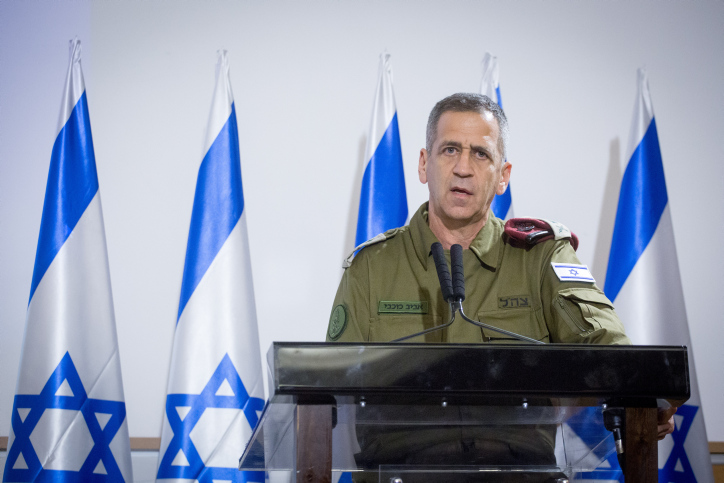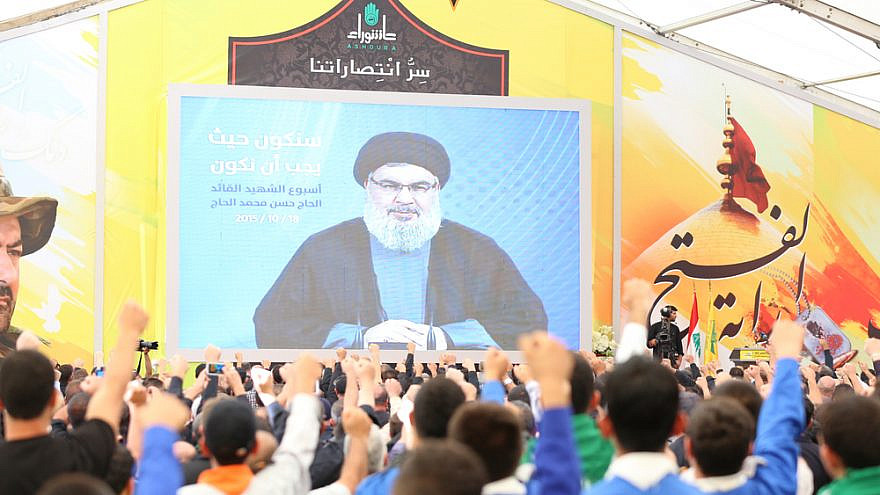In recent days, Hezbollah launched a high-profile public campaign that included threats to strike sensitive targets deep inside Israel in response to recent Israeli warnings about the consequences of future Hezbollah miscalculations, as well as its systematic use of human shields to hide its firepower in Lebanese residential areas.
But the latest messages by Hezbollah are primarily aimed at a domestic Lebanese audience, according to a former Israeli intelligence officer, and are designed to create a false moral equivalency between the Iranian-backed terror army and the State of Israel.
Maj. (res.) Tal Beeri, director of the research department at Alma Research and Education Center, who spent 20 years as an intelligence officer in the Israel Defense Forces specializing in Lebanon and Syria, told JNS a speech by IDF Chief of Staff Lt. Gen. Aviv Kochavi in late January triggered Hezbollah’s own messages.
During his remarks, Kochavi drew special attention to the ways in which Hezbollah embedded its missile sites and additional military sites in civilian areas using the human-shielding tactics, warning that this will not prevent the IDF from attacking those targets in the event of war to defend Israeli citizens from Hezbollah’s fire.

On Feb. 16, Nasrallah delivered a speech to mark a day that Hezbollah commemorates “martyrs,” including the previous secretary-general of the organization, Abbas Musawi, who was assassinated in an Israeli helicopter strike in 1992, and Imad Mughniyeh, Hezbollah’s notorious chief of staff who was killed in a Damascus bombing.
During that speech, Nasrallah chose to create “counter equations” to Kochavi’s warnings, said Beeri. The Hezbollah chief claimed that there was no difference between Israeli civilians and soldiers since all Israelis serve in the reserves, and threatened that the Israeli home front would experience damage in the next war the likes of which it had never previously seen.
“He said that Hezbollah will hit where it wants to, and that any harm to Lebanese villages, towns or cities will see counterstrikes on Israeli villages towns and cities,” added Beeri.
Hezbollah has always placed a strong emphasis on psychological warfare, he argued, and accompanies its messages with video clips and songs. True to form, on Feb. 17, a day after Nasrallah’s speech, Hezbollah released a video featuring satellite images of Israeli targets and their coordinates.
Beeri noted that the targets included the IDF’s Central Headquarters in Tel Aviv, the headquarters of its divisions on the Lebanese borders, a radar site in Haifa, a power plant in Ashkelon and even the antenna array on Haifa University, among others. Two military defense company sites were also shown.
“Hezbollah is saying Israel also uses human shielding, so what is the problem with us doing it?” said Beeri.
Yet some of the targets that Hezbollah presented are explicitly civilian, such as the University of Haifa and the Ashkelon power plant, he stated. In addition, “unlike the IDF, Hezbollah is not the official military of Lebanon. It is not subordinate to the Lebanese state. The equation is not comparing equal things,” said Beeri. “The Israeli sites are not using civilian areas for cover. These are official military sites that everyone recognizes as such. There are no weapons hidden there that can suddenly be launched, no disguised missile-launchers.”
Hezbollah, on the other hand, hides its sites and presents them as civilian in every way.
The fact that Hezbollah’s latest video is in Arabic is further indication that the messaging is directed towards the Lebanese people, assessed Beeri, adding, “they are the ones who know and experience firsthand Hezbollah’s human-shielding tactics. A big part of this approach rests on intimidating opponents to it. Ultimately, this is an intimidation campaign for Lebanon. It’s designed to legitimize Hezbollah’s actions and to fend off criticism.”

Hezbollah has denied any connection to the deadly Aug. 4 explosions at Beirut Port, which killed as many as 200 people, injured thousands, left hundreds of thousands homeless and caused widespread damage. The blast, however, is a reminder of the deep dysfunction of Lebanon’s government and served at least as an indirect reminder of the fact that explosive material has been embedded by Hezbollah throughout Beirut and southern Lebanon.
Israel has in the past warned about Hezbollah’s use of Beirut’s seaports and airports for the import of Iranian weapons, with the former Israeli Ambassador to the United Nations Danny Dannon stating in 2019, “Israel discovered that Iran and its Quds Force have been exploiting civilian maritime channels, and specifically the Port of Beirut. The Iranian regime is transferring weapons in various ways. They use commercial companies, mainly from Europe, to support Hezbollah and develop its missile program. Unfortunately, the port of Beirut has become Hezbollah’s port.”


























